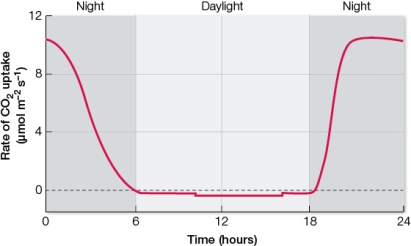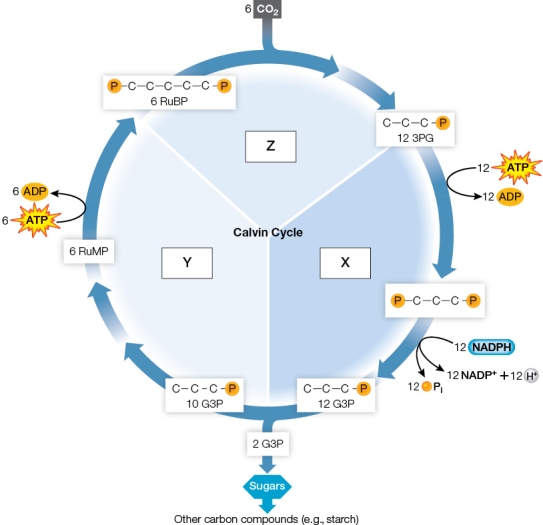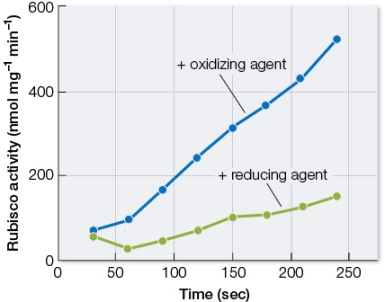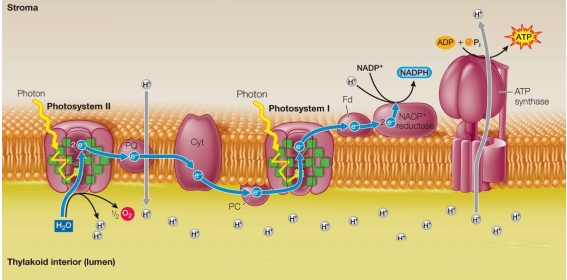A) the splitting of water.
B) the reduction of oxygen.
C) the oxidation of sugars.
D) cyclic electron transport.
E) noncyclic electron transport.
G) B) and D)
Correct Answer

verified
Correct Answer
verified
Multiple Choice
Which statement regarding the electron transport chain between photosystem II and photosystem I is true?
A) Its terminal electron acceptor is oxygen.
B) Its terminal electron acceptor is P680.
C) Most of its components are found in the lumen of the thylakoid.
D) It generates a pH gradient that supplies the energy for ATP synthesis.
E) It generates NADPH.
G) B) and C)
Correct Answer

verified
Correct Answer
verified
Short Answer
A group of scientists led by Melvin _______ conducted experiments demonstrating that RuBP is the CO2 acceptor in the dark reactions of photosynthesis.
Correct Answer

verified
Correct Answer
verified
Short Answer
Refer to the graph below.  This graph was generated using data collected over a 24-hour period on the rate of carbon dioxide uptake by a leaf on a living plant.Based on the pattern revealed by the data, it can be concluded that the plant can be classified as a _______ plant.
This graph was generated using data collected over a 24-hour period on the rate of carbon dioxide uptake by a leaf on a living plant.Based on the pattern revealed by the data, it can be concluded that the plant can be classified as a _______ plant.
Correct Answer

verified
Correct Answer
verified
Multiple Choice
Refer to the figure below.  In the figure, how should boxes X, Y, and Z be labeled?
In the figure, how should boxes X, Y, and Z be labeled?
A) X = regeneration of RuBP, Y = carbon fixation, Z = reduction and sugar production
B) X = carbon fixation, Y = reduction and sugar production, Z = regeneration of RuBP
C) X = reduction and sugar production, Y = regeneration of RuBP, Z = carbon fixation
D) X = regeneration of RuBP, Y = reduction and sugar production, Z = carbon fixation
E) X = reduction and sugar production, Y = carbon fixation, Z = regeneration of RuBP
G) B) and C)
Correct Answer

verified
Correct Answer
verified
Multiple Choice
How many micromoles of 3-phosphoglycerate would be formed by rubisco if 4 M of RuBP were added to the solution in the presence of CO2 and the absence of O2?
A) 1
B) 2
C) 4
D) 8
E) 16
G) A) and C)
Correct Answer

verified
Correct Answer
verified
Multiple Choice
In the hydrolysis of H2O to protons and oxygen during photosynthesis, electrons are transferred to P680.This reaction is an example of
A) a redox reaction.
B) a metabolic pathway.
C) oxidative phosphorylation.
D) the creation of a proton gradient.
E) an aerobic reaction.
G) All of the above
Correct Answer

verified
Correct Answer
verified
Short Answer
The light-independent reactions cannot run without the products of the _______ reactions.
Correct Answer

verified
Correct Answer
verified
Multiple Choice
In noncyclic electron transport, electrons from _______ replenish chlorophyll molecules that have given up electrons.
A) CO2
B) H2O
C) NADPH + H+
D) O2 gas
E) ATP
G) A) and B)
Correct Answer

verified
Correct Answer
verified
Multiple Choice
The chemical energy stored from photosynthesis represents _______ percent of the total energy of the sunlight hitting a green leaf.
A) 5
B) 10
C) 30
D) 50
E) 100
G) A) and C)
Correct Answer

verified
Correct Answer
verified
Multiple Choice
The enzyme PEP carboxylase
A) can fix CO2 even at relatively low CO2 concentrations.
B) catalyzes the synthesis of RuBP.
C) catalyzes the synthesis of 3PG.
D) is found in the chloroplasts of bundle sheath cells.
E) couples the synthesis of ATP to the diffusion of protons.
G) B) and C)
Correct Answer

verified
Correct Answer
verified
Multiple Choice
The first product of CO2 fixation in C4 plants is
A) rubisco.
B) 3-phosphoglycerate (3PG) .
C) oxaloacetate.
D) PEP.
E) RuBP.
G) C) and D)
Correct Answer

verified
Correct Answer
verified
Multiple Choice
Refer to the graph below summarizing data collected using rubisco purified from chloroplasts.It shows how the catalytic activity of rubisco changes in response to varying times of incubation, either with an oxidizing agent or with a reducing agent.  Thioredoxin is a protein inside the stroma of a chloroplast that can act as an oxidizing or a reducing agent.Thioredoxin is reduced by ferredoxin in photosystem I.Based on this information and the graph, how do you predict thioredoxin will affect rubisco inside cells of a living plant when the plant is moved from the dark into the light?
Thioredoxin is a protein inside the stroma of a chloroplast that can act as an oxidizing or a reducing agent.Thioredoxin is reduced by ferredoxin in photosystem I.Based on this information and the graph, how do you predict thioredoxin will affect rubisco inside cells of a living plant when the plant is moved from the dark into the light?
A) Rubisco activity will remain constant, as thioredoxin will not change.
B) Rubisco activity will increase because thioredoxin will become a reducing agent.
C) Rubisco activity will increase because thioredoxin will become an oxidizing agent.
D) Rubisco activity will decrease because thioredoxin will become a reducing agent.
E) Rubisco activity will decrease because thioredoxin will become an oxidizing agent.
G) A) and B)
Correct Answer

verified
Correct Answer
verified
Multiple Choice
In noncyclic photophosphorylation, oxidized chlorophyll in photosystem I returns to its reduced state by
A) splitting water.
B) accepting electrons from photosystem II through the electron transport chain.
C) absorbing two photons of light.
D) taking electrons from NADPH.
E) hydrolyzing ATP.
G) B) and D)
Correct Answer

verified
Correct Answer
verified
Multiple Choice
Refer to the table below showing data collected from chloroplasts isolated from spinach leaves.The chloroplasts were incubated with either compound Q or Z, or with no additions in the control.After 30 minutes of incubation, chloroplasts were analyzed for the photosynthetic functions shown in the table.  Assume that compounds Q and Z directly affect components involved in the light reactions.What do these data indicate about the relationship between the light reactions and the light-independent reactions?
Assume that compounds Q and Z directly affect components involved in the light reactions.What do these data indicate about the relationship between the light reactions and the light-independent reactions?
A) The light-independent reactions can occur even if the light reactions are inhibited by chemical agents.
B) If a subset of the light reactions is functional, that is sufficient for the light-independent reactions to also be functional.
C) At least one of the products of the light reactions is essential in enabling the light-independent reactions to run.
D) Chemical agents can reverse the sequence of the light reactions and the light-independent reactions.
E) Light reactions and light-independent reactions can be induced to reverse their dependency on light by the actions of chemical agents.
G) B) and C)
Correct Answer

verified
Correct Answer
verified
Multiple Choice
A graph that plots the rate at which CO2 is converted to sugar versus the wavelength of light illuminating a leaf is called
A) a Planck equation plot.
B) an absorption spectrum.
C) an enzyme kinetics plot.
D) an electromagnetic spectrum.
E) an action spectrum.
G) None of the above
Correct Answer

verified
Correct Answer
verified
Multiple Choice
The first step in noncyclic electron transport includes
A) the P680 reaction center being excited by a photon.
B) water being oxidized by oxygen.
C) NADPH being produced.
D) electrons flowing through plastoquinone (PQ) .
E) protons being actively transported into the thylakoid lumen.
G) A) and C)
Correct Answer

verified
Correct Answer
verified
Short Answer
Refer to the figure below.  Based on the process shown in the figure, it can be predicted that the pH in the stroma will _______ when a green plant is exposed to light.
Based on the process shown in the figure, it can be predicted that the pH in the stroma will _______ when a green plant is exposed to light.
Correct Answer

verified
Correct Answer
verified
Multiple Choice
Which statement about chlorophyll is false?
A) Chlorophyll appears green because it reflects green light.
B) Most of the chlorophyll in a plant functions to gather light.
C) Chlorophyll is present in light-harvesting complexes also known as antenna systems.
D) Most of the chlorophyll in a plant participates in an oxidation-reduction reaction.
E) Chlorophyll contains Mg2+.
G) A) and E)
Correct Answer

verified
Correct Answer
verified
Short Answer
The net chemical changes that result from photosynthesis can be summarized in the following balanced chemical equation: 6 CO2 + 6 H2O C6H12O6 + 6 O2 However, this equation can be made more complete by adding the word "energy" to the (left/right) _______ side of the equation to show how energy is involved in this process.
Correct Answer

verified
Correct Answer
verified
Showing 221 - 240 of 242
Related Exams